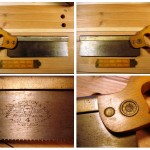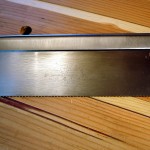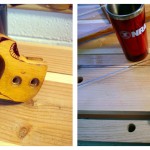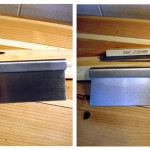It’s time to do something about a woefully inadequate saw collection. Other than my shopmade frame saw and shopmade turning saw, my other saws are modern disposables that probably wouldn’t be good enough for a rough carpentry contractor.
Mass production of western style handsaws started a nose dive in the middle of the last century and have brought us to cheap, colorful, plastic handled blister raisers with brittle teeth that can’t be sharpened. Yes, there are a few premium western saw makers currently making superb saws. If those are your fancy, a good Google search will find many of them for you. For myself, I like refurbishing older tools. So, it was off to eBay to find my first goal, a small back saw suitable for fine joinery.
 This Disston Nbr. 4 is has a 10 inch blade, has a plate depth of 2.5 inches under the back, plate thickness of 0.031″, is filed for 12 teeth per inch rip, and has a steel back. The blocky, semi-ugly beech handle dates it to after 1940. There’s no stamping on the back (also after 1940), and the etch on the plate dates it to the post WW II era. Disston was sold in 1956, placing that as the most recent date possible for this saw. This saw had a very easy life. It was barely used and apparently kept in a comfortable place. The handle seems to have original factory finish, with no chips or other damage, not even significant scratches, but some runs. There’s a little bit of donor paint and other stains. The blade has minor rust, a bit of pitting, and “patina.” The teeth are still relatively sharp. The tooth line has an ever so slight bow. The spine has no visible bowing. Before I did anything with it, I tried a few test cuts and found it maybe 20% slower than the spectacular yellow and black Stanley utility saw.
This Disston Nbr. 4 is has a 10 inch blade, has a plate depth of 2.5 inches under the back, plate thickness of 0.031″, is filed for 12 teeth per inch rip, and has a steel back. The blocky, semi-ugly beech handle dates it to after 1940. There’s no stamping on the back (also after 1940), and the etch on the plate dates it to the post WW II era. Disston was sold in 1956, placing that as the most recent date possible for this saw. This saw had a very easy life. It was barely used and apparently kept in a comfortable place. The handle seems to have original factory finish, with no chips or other damage, not even significant scratches, but some runs. There’s a little bit of donor paint and other stains. The blade has minor rust, a bit of pitting, and “patina.” The teeth are still relatively sharp. The tooth line has an ever so slight bow. The spine has no visible bowing. Before I did anything with it, I tried a few test cuts and found it maybe 20% slower than the spectacular yellow and black Stanley utility saw.
 Since it is neither rare nor collectable, and screams won’t be heard if I don’t leave it “pristine,” I intend to refurbish it in the manner pursued by Andy “Brit.” That means a very shiny plate. After disassembling, the first stop was in an Evapo-Rust bath. This is the very first “eco friendly” clean-up product that actually has the strength to do what it advertises. Mild rust was gone quickly. Then it’s off to the polishing. I used garnet paper starting at about 250 grit, then wet-n-dry to 600, followed by Abralon sanding pads to 4000. The purists will be upset with losing part of the etch, but it’s a “user” not a collector’s item. That slight bow was removed by clamping the saw in my really simple “saw vise” just above the tooth line and then tapping along the spine with moderate hammer blows buffered by an oak block.
Since it is neither rare nor collectable, and screams won’t be heard if I don’t leave it “pristine,” I intend to refurbish it in the manner pursued by Andy “Brit.” That means a very shiny plate. After disassembling, the first stop was in an Evapo-Rust bath. This is the very first “eco friendly” clean-up product that actually has the strength to do what it advertises. Mild rust was gone quickly. Then it’s off to the polishing. I used garnet paper starting at about 250 grit, then wet-n-dry to 600, followed by Abralon sanding pads to 4000. The purists will be upset with losing part of the etch, but it’s a “user” not a collector’s item. That slight bow was removed by clamping the saw in my really simple “saw vise” just above the tooth line and then tapping along the spine with moderate hammer blows buffered by an oak block.
 The handle is actually beyond semi-ugly. It is downright ugly and uncomfortable too. It wants some serious reshaping. Any self-respecting saw handle would like to look the part, and I wanted to soften some hard lines, and have a finish that did not includes the runs and curtains of the original poor manufacture. Search around and you’ll see that classic handles had a nib on the top, a lamb’s tongue on the bottom, and curves that actually flowed nicely. Out came my marker, turning saw, a few gouges and a couple of rasps. Reshaping it was so much fun that I lost track of time, maybe and hour or two. Finish is three coats of shellac followed by paste wax applied with steel wool. Satin s-m-o-o-o-o-o-o-t-h! The brass finished up relatively quickly with the Abralon pads followed by rottenstone in wax and buffing.
The handle is actually beyond semi-ugly. It is downright ugly and uncomfortable too. It wants some serious reshaping. Any self-respecting saw handle would like to look the part, and I wanted to soften some hard lines, and have a finish that did not includes the runs and curtains of the original poor manufacture. Search around and you’ll see that classic handles had a nib on the top, a lamb’s tongue on the bottom, and curves that actually flowed nicely. Out came my marker, turning saw, a few gouges and a couple of rasps. Reshaping it was so much fun that I lost track of time, maybe and hour or two. Finish is three coats of shellac followed by paste wax applied with steel wool. Satin s-m-o-o-o-o-o-o-t-h! The brass finished up relatively quickly with the Abralon pads followed by rottenstone in wax and buffing.
 Lastly, comes sharpening. I’m constantly amazed at how many people think saw sharpening some mysterious art. I see it as a fundamental skill for anyone working with hand tools. Why send something out to be sharpened? Why bear the expense and delay. (Some of those premium saw makers offer sharpening services, but have backlogs measured in weeks and months.) Learning to sharpen a saw is something that can be accomplished in only a couple of hours and is a lifetime skill that improves whenever you use it. Once you know how, you can sharpen a saw in less time than it takes to stand in line at the post office. Learn here, or if you’re a member of Paul Seller’s Woodworking Masterclasses online school, learn here. Also, be aware that rip filings do cross cutting surprisingly well, so you can do a lot with the simplest filing technique. I used Seller’s advice and filed the first dozen teeth at the toe of this saw with 10-12 degrees of rake. The next dozen teeth were filed at 5-8 degrees of rake, and all the rest at zero degrees of rake. The idea is to use the toe for easy starting and to have aggressive rake for the remainder of the blade. Time: about 20 minutes. The saw arrived with quite a lot of set. Some disappeared in the filing, but a noticeable amount remained. Test cuts now make this saw about 20% faster than the spectacular yellow and black Stanley utility saw. It cuts rip very smoothly and cross cut slightly less smoothly, but acceptably fast. It’s faster in hardwood than in softwood, indicating I need just a little more set. … tomorrow’s improvement.
Lastly, comes sharpening. I’m constantly amazed at how many people think saw sharpening some mysterious art. I see it as a fundamental skill for anyone working with hand tools. Why send something out to be sharpened? Why bear the expense and delay. (Some of those premium saw makers offer sharpening services, but have backlogs measured in weeks and months.) Learning to sharpen a saw is something that can be accomplished in only a couple of hours and is a lifetime skill that improves whenever you use it. Once you know how, you can sharpen a saw in less time than it takes to stand in line at the post office. Learn here, or if you’re a member of Paul Seller’s Woodworking Masterclasses online school, learn here. Also, be aware that rip filings do cross cutting surprisingly well, so you can do a lot with the simplest filing technique. I used Seller’s advice and filed the first dozen teeth at the toe of this saw with 10-12 degrees of rake. The next dozen teeth were filed at 5-8 degrees of rake, and all the rest at zero degrees of rake. The idea is to use the toe for easy starting and to have aggressive rake for the remainder of the blade. Time: about 20 minutes. The saw arrived with quite a lot of set. Some disappeared in the filing, but a noticeable amount remained. Test cuts now make this saw about 20% faster than the spectacular yellow and black Stanley utility saw. It cuts rip very smoothly and cross cut slightly less smoothly, but acceptably fast. It’s faster in hardwood than in softwood, indicating I need just a little more set. … tomorrow’s improvement.
All done, I’ve sharpened some skills, saved an old saw from a trip to the land fill, gained what I consider a premium saw, and did it for about 1/10th the cost of a new premium saw.
Just wait til you see the next one…
Nice job Bob. The tote is a 100% improvement over the original. I’ve tried to sharpen my own saws (yard sale beaters) and all I got from it was a headache. I just can’t seem to focus on something that small.
Bob,
You have inspired me! I, too, have had an old Disston kicking around, got it at a used tool store for $4.75, and it’s been sitting on a pile for over a year. I think it’s a tenon saw – it’s over a foot long and about four inches between back and teeth.
After I read this post, I went downstairs today and had at it. Cleaned up the rust on the plate and back, took off the handle with the intention of reshaping it like you did, but spent so much time removing rust that I was out of energy to carve / shape beech 🙂 I did, though, put it in my old saw vise and take a small file to it – first saw I ever sharpened! I didn’t think I did very well, so I tried first to cut some oak, and it cuts better than my Veritas Dovetail saw! I did go off the line, though, so, remembering the Ron Herman DVD I got when I first got the saw (best intentions, right?) I honed the side of the teeth on the side it was driving off the line with a stone, and, after a couple of tries it now cuts straight.
My greatest pleasure was when I took it to a piece of pine – that thing went through nearly two inches every stroke! Three strokes and I was at the back of the saw! May not have sharpened it perfectly, but, as I have read, a badly sharpened saw is still better than a dull one 🙂
Thanks so much for all your inspirations (and for helping get Mary May’s carving school going, thoroughly enjoying membership there!)
David Taylor
$4.75? Dang!
Now, that’s what I like hearing; another great restoration story. Thanks for telling it David.
Your story proves one of my long held beliefs. That is, people can learn to do almost anything well, — IF — they have a strong enough interest.
It also proves something else. Your Veritas saw needs sharpening.
Keep havin’ fun … and show us some pictures of your carving and other woodworking.
Hi Bob,
Just catching up on your blog through my RSS reader. What a great job you made of that No.4. Obviously a man after my own heart. LOL. That saw will not only serve you well, but will now go on for another generation because you showed it some love.
Take care,
Andy